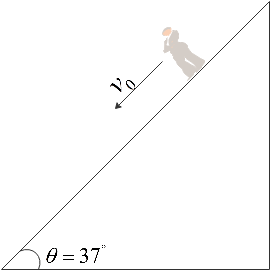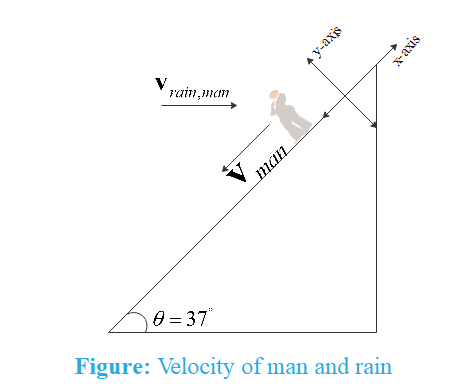
A man is moving downward on an inclined plane (

A.
B.
C.
D.

Answer
479.7k+ views
Hint: Velocity of an object is the rate of change of position. It is a vector quantity and thus, has both magnitude and direction.
The velocity of man and relative velocity of rain is given. The relative velocity of the object A with respect to B is defined as the velocity of object A in the rest frame of object B.
First, resolve the velocity of man and relative velocity of rain in its vector components, obtain velocity of rain with respect to ground. Then, after man increases his velocity, obtain relative velocity of rain.
Complete step-by-step answer:
Velocity of an object is defined as its displacement per unit time. It is a vector.
Relative velocity of the object A with respect to B tells us the velocity of object A in the rest frame of object B.

The observer is moving with velocity
The relative velocity of rain with respect to man is
We get velocity of rain with respect to ground as
If man increases his velocity to
The velocity of rain drops as observed by man after increasing his speed is the relative velocity i.e.
Magnitude of velocity of rain is
Since, we have
Hence, option A is correct.
So, the correct answer is “Option A”.
Note: Velocity is a vector quantity and has both magnitude and direction.
The relative velocity of an object A with respect to B is defined as its velocity in the rest frame of object B.
Vector sum of any two quantities is the sum of their corresponding components.
The velocity of man and relative velocity of rain is given. The relative velocity of the object A with respect to B is defined as the velocity of object A in the rest frame of object B.
First, resolve the velocity of man and relative velocity of rain in its vector components, obtain velocity of rain with respect to ground. Then, after man increases his velocity, obtain relative velocity of rain.
Complete step-by-step answer:
Velocity of an object is defined as its displacement per unit time. It is a vector.
Relative velocity of the object A with respect to B tells us the velocity of object A in the rest frame of object B.

The observer is moving with velocity
The relative velocity of rain with respect to man is
We get velocity of rain with respect to ground as
If man increases his velocity to
The velocity of rain drops as observed by man after increasing his speed is the relative velocity i.e.
Magnitude of velocity of rain is
Since, we have
Hence, option A is correct.
So, the correct answer is “Option A”.
Note: Velocity is a vector quantity and has both magnitude and direction.
The relative velocity of an object A with respect to B is defined as its velocity in the rest frame of object B.
Vector sum of any two quantities is the sum of their corresponding components.
Recently Updated Pages
Master Class 11 Economics: Engaging Questions & Answers for Success

Master Class 11 Business Studies: Engaging Questions & Answers for Success

Master Class 11 Accountancy: Engaging Questions & Answers for Success

Master Class 11 English: Engaging Questions & Answers for Success

Master Class 11 Computer Science: Engaging Questions & Answers for Success

Master Class 11 Maths: Engaging Questions & Answers for Success

Trending doubts
State and prove Bernoullis theorem class 11 physics CBSE

What are Quantum numbers Explain the quantum number class 11 chemistry CBSE

Write the differences between monocot plants and dicot class 11 biology CBSE

Why is steel more elastic than rubber class 11 physics CBSE

Explain why a There is no atmosphere on the moon b class 11 physics CBSE

1 ton equals to A 100 kg B 1000 kg C 10 kg D 10000 class 11 physics CBSE




